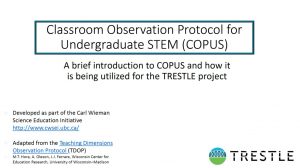COPUS Observations Resources
The Classroom Observation Protocol for Undergraduate STEM (COPUS) was developed through the Carl Wieman Science Education Initiative at the University of British Columbia. This protocol was adapted from the Teaching Dimensions Observation Protocol and can be used to reliably characterize how faculty and students are spending their time in the classroom. Check out the powerpoint and video included below to learn more about COPUS and to see examples of COPUS observation codes in a biology classroom at the University of Kansas.
The TRESTLE project has been utilizing COPUS as an observational tool to help evaluate the impact of the model that is being implemented across each campus. Through the TRESTLE collaboration, the original code descriptions have been elaborated with an additional FAQ section that can help aid observers in a classroom. A copy of these updated observation codes can be found in the resource list on this page.
The results of COPUS observations can be a valuable resource for instructors to reflect on their own teaching practices. TRESTLE campuses have been utilizing the COPUS Visualization files developed by the Teaching Engagement Program at the University of Oregon. These user-friendly visualization files allow users to see the occurrence of classroom activities by time after an observation has been completed. Using this, TRESTLE participants at the University of Kansas have been provided a report afterwards that highlights the activities that occurred in their classroom. A sample report can be found in the resources list on this page.
“It was really useful to see, literally, how the time passes in class. This was very useful to me.”
– Dr. Michael Murray, University of Kansas Department of Physics and Astronomy
This material is based upon work supported by the National Science Foundation under Grant Number DUE1525775 (KU), DUE1525331 (CU) and DUE1525345 (UTSA). Any opinions, findings, and conclusions or recommendations expressed in this material are those of the author(s) and do not necessarily reflect the views of the National Science Foundation.


